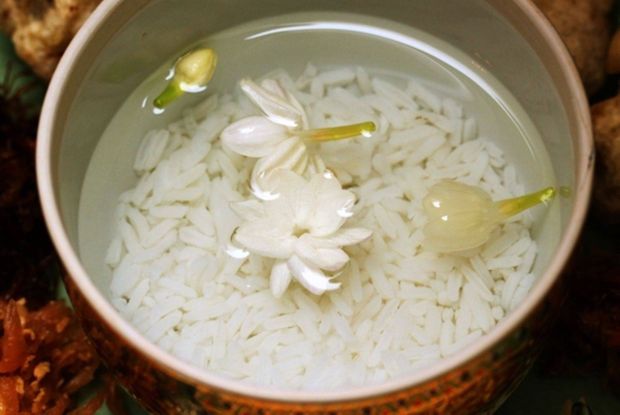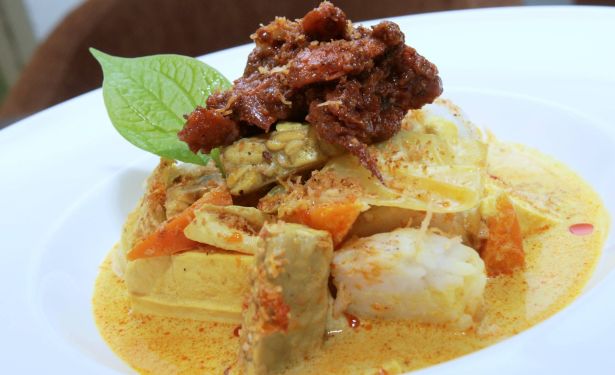If you can cajole Erawan’s chef, Korn Yodsuk, into making you a Khao Chae dinner, then you are in for a right royal meal.
THE colourful sticky rice balls with prawn stuffing were exquisite, tumbling out the heat of pepper and the delicious scent of coriander root.
They made amazing bites and were a nice preamble to our special Khao Chae dinner recently at Erawan Classic Thai & Fusion Restaurant in Kota Damansara, Petaling Jaya.
“The rice balls are usually served in the palace. It’s like a Thai dimsum,” said Erawan’s Thai chef Korn Yodsuk, whose grandma served King Rama VII, and from whom he has inherited many recipes.
 Superstar side dish: Deep-fried shrimp paste balls go down a treat with Khao Chae,rice in cold jasmine water(below).
Superstar side dish: Deep-fried shrimp paste balls go down a treat with Khao Chae,rice in cold jasmine water(below).I also loved the Secret Garden, Erawan’s starter of a prawn buried in carrot and radish pickle together with mint, kaffir lime leaf and basil.
The way to eat it, according to the chef, is to start from the top and work your way to the bottom. So you sink your teeth into the fragrant leaves, then the prawn and then the pickles. Korn’s passion for cooking was the reason he accepted our request for a Khao Chae dinner.
Khao Chae is a meal of rice in cold jasmine-scented water, served with at least seven delicacies, usually at lunch time. It was the favourite of King Rama V, who loved cooling off with a meal like this in the hot summer months, from March to May.
Khao Chae originated in Burma, said Korn, where the people used to offer it up as a feast to the gods.
“They used a lot more dishes but they were very salty. The Thais changed the dishes to something sweet and easy to eat, with just seven or eight items,” Korn explained.
A Khao Chae meal requires laborious preparations. In the old days, more than 10 people would be involved in preparing the meal for the king. Korn, however, worked alone on our Khao Chae, using the free time from his busy restaurant hours to do it. The preparations took a whole week but he found the experience challenging and fulfilling.
The seven delicacies Korn chose included salted fish with crispy shallots, salted vegetables fried with egg, beef jerky, pickled radish stir-fried with garlic and egg, deep-fried shrimp paste balls, deep-fried stuffed shallots, and stuffed green chillies.
The rice were served in beautiful benjarong (Thai porcelain) bowls in cold water with jasmine blossoms from Korn’s own garden floating on it.
Korn explained how the rice was parboiled, gently hand-washed about 20 times till the water was clear. It was then wrapped in a muslin cloth before being steamed till just cooked and then smoked with a Thai aroma candle for half an hour.
It was all organically done. Korn even washed the rice with mineral water.
The night before the meal, Korn floated jasmine blossoms in the water. Next morning, he put the water into a bowl and smoked it with aroma candle for half an hour. The scented rice was served in this special flower water. We were told to use our hand to eat, starting with a delicacy and following with rice.
It was an incredible experience. First I picked up the salted fish. The fish had been grilled and pounded with the pestle till it became puffy, then stir-fried with garlic, sugar and topped with crispy shallots. The sweet and the salty collided sublimely, and it was very good with the fragrant and refreshing rice.
The salted vegetables (kai choy), which Korn meticulously made from scratch himself, were stir-fried with garlic, egg and sprinkled with sugar. Like the salted fish, it was an exquisite match for the rice.His finely cut pickled radish was similarly stir-fried with garlic, egg and sugar.
I loved the beef jerky, too. It is beef marinated with soya sauce and dried in the sun for a day before being grilled and pounded with the pestle. Korn tore the meat into small pieces, then stir-fried it with garlic and sugar and topped it with crispy shallots.
The deep-fried shrimp paste balls were the superstars, said the chef. And so they proved. At a bite, the crispy tempura skin gave way to the myriad nuances inside. You would pause and try to identify each delightful sensation.
“They are the most difficult to prepare. We pound together grilled catfish, garlic, shallot, chilli and kaffir lime skin till fine, then combine the mixture with roasted coconut, palm sugar and shrimp paste. I stir these with coconut cream in the pan till they become a ball, then shape them, dip in tempura batter and deep-fry.”
Korn made a big portion of these so that he could enjoy them with his restaurant partner Anan later. “In Thailand, this is seldom served with Khao Chae; only in five-star hotels can you find it,” he said.
The stuffed shallots, meanwhile, required that that the centre first be cut out. They were then stuffed with a mixture of grilled catfish, chilli, leek, garlic, coriander root and a little wild ginger cooked in coconut cream, then dipped in batter and deep-fried. The sweet shallots with the fragrant, sweet filling were simply wonderful.
His stuffed green chillies came covered in an egg net. Chopped shrimps, garlic, pepper and coriander root made up the main ingredients for the filling. Once stuffed, the chillies were steamed, then wrapped in an egg net made from duck and chicken eggs.
I was happily replete, having left not a single grain of rice in my bowl nor a drop of the jasmine-scented water, when I was wowed by a beautiful platter of Luk Chup – almost real eggplant, cherries and kumquat made with mungbean and dipped into agar-agar three times.
The Luk Chup had also been smoked with an aroma candle. It was a heavenly end to an incredible dinner.
Erawan Classic Thai & Fusion (pork-free) ranked fifth in the prestigious Miele Guide last year. You can view its menu on its website http://www.erawan-classicthai.com/ and make your orders before going to the restaurant. It is located at No.22-1, Jln PJU 5/16, Dataran Sunway Kota Damansara, Petaling Jaya. tel; 03-6141 2393.





